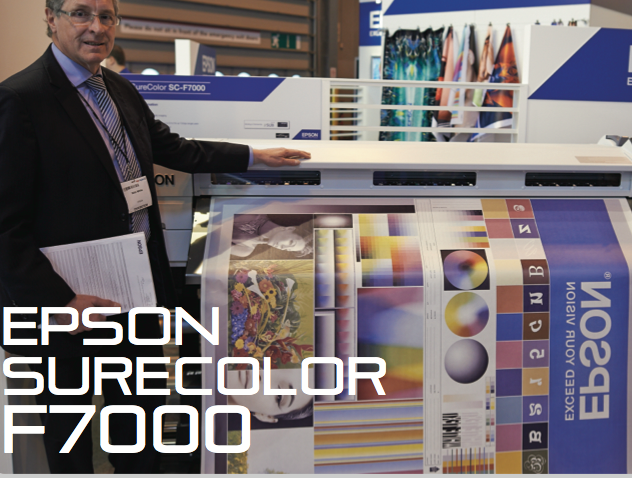Nessan Cleary takes a look at the machine that heralds Epson’s move into the textile printing market.
Late last year Epson announced its intentions to get into textile printing with two new dye-sublimation printers, one of which was the 64in wide Surecolor SC-F7000. This machine was subsequently officially launched at this year’s Sign and Digital show with quite a number now established in the field.
Nick White, Epson’s business manager for professional graphics products in the UK, explains: “Textile printing is quite widespread in the UK. Soft signage and graphics and printing to textiles is a growing market and the shift to digital printing of textiles is very noticeable, so that's why we are moving into this area.”
The SC-F7000 is a roll-to-roll printer designed to print to transfer papers up to 260gsm, with the images subsequently being sublimated to the textiles via a separate heat press. It’s targeted at a range of applications from banners and flags through to soft furnishings and interior decoration but, White expects a lot of customers will also use it for garments such as customised sportswear.
It’s been designed entirely by Epson, and White is quick to point out that the company is the only vendor in this sector that manufactures all the components that go into the printer. It is based on the chassis of the Surecolor S30600, a proven performer that was always designed to be the base for future printers. Thus the SC-F7000 shares the same automated media loading system and a similar LCD control panel.
Naturally it uses an Epson micro piezo printhead, the TFP-AD, which White says was developed specifically to handle the water-based dye-sublimation inks and isn’t used in any other model. This gives it a maximum resolution of 720 x 1440dpi. It prints at a rate of 16 - 57m2/hr, though Epson expects most customers will run it in two-pass mode at 30m2/hr.
However, Epson has redesigned the ink system, with the inks for the F-series machines sold in one-litre bags as opposed to the 700ml cartridges that most other Epson printers use. The bags are seen as a more environmentally friendly option and better suited to long print runs. The printer itself has a 1.4 litre tank so that there’s plenty of leeway in refilling the inks. Epson still uses a chip to monitor how much ink is being used and to ensure that the right ink has been loaded. The chips are stored behind the ink bay on the front of the machine.
Epson has formulated its own dye-sublimation ink, branded as UltraChrome DS. This is a water-based ink capable of producing very vibrant colours with good contrast and gradation. Epson says that the prints are lightfast, as well as resistant to abrasion and perspiration, and that they will withstand the level of washing expected of garments these days.
The F7000 is priced at £15,695, which includes a year’s warranty. It comes with an ErgoSoft Rip though White says that Epson has no particular bias towards any Rip vendors and so it should work with any available Rip.
There’s also a smaller, 44in version, the F6000, based on the SC-T7000. White says that the features are the same on both machines but that the F6000 is seen more as an entry-level model while the F7000 caters for larger, more established customers producing rolls in volume for later sublimation rather than on-demand for smaller orders. Both machines are distributed through specialist resellers i-Sub and RA Smart, which have built up good reputations in the digitally printed textiles business.
Alternatives
There are several alternative dye-sublimation printers around at this sort of price. Mimaki, for example, sells the JV33 which has similar resolution but prints at 20m/2hr. It’s available in 1.3 and 1.6m widths. Mutoh sells the ValueJet 1638W, which also uses Epson printheads but uses Mutoh’s own Disperse Dye inks and runs at 65m2/hr.


